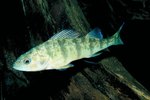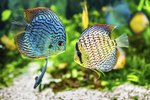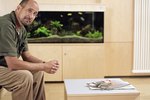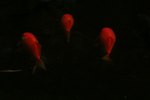Things You'll Need
2 barrels, 55 gallons each
Aquarium Gravel
Filter for 55 Gallon Aquarium
Circulation Pump or Aerator
Garden Hose
Thermometer
2 panes of glass or sheets or clear plastic, large enough to cover the barrels
Commercial chlorine removal product
40 fingerling fish
12,000 red wigglers
Compost or earthworm bedding
Warnings
Check your worm compost regularly and monitor the pH as acid can build up very quickly and decimate your entire earthworm supply. Earthworm bedding should have a pH of 5.5 to 6.5.
Tips
To have a continual supply of home grown fish, use more than one tank, starting a new one every 8 weeks throughout the calendar year. To expand your fish farm operation, move everything from the 55 gallon barrel into an above ground pool, 25 feet in diameter and a minimum of 3 feet deep, covered with a clear plastic tarp and utilizing a pool sized filter and circulation pump or aerator.
Any new venture has its risks, but none seem to outweigh the potential rewards as much as fish farming. It is simple, safe and requires very little to get started in terms of both equipment and cash. You can, from your own back yard, raise fish to eat for a fraction of what it costs in the stores. You can rear catfish, carp, bluegill or bass from fingerling size to adulthood in nothing bigger than a 55 gallon barrel by following the steps in this guide.
Find a location for your fish. Search for a level area approximately 12 square feet in size, in partial shade, near a source of water or within reach of your garden hose.
Prepare your fish barrel. Clean both barrels and rinse well. Place 4 inches of gravel on the bottom of one barrel and situate the filter firmly in the substrate.
Attach a circulation pump or aerator to the fish barrel to ensure there is adequate oxygen in the water and secure a garden hose to the bottom of the barrel to ease in the daily replacement of the tank water.
Attach a thermometer to the side of the barrel in a location which will allow the bulb to be submerged. The ideal temperature for your fish tank is between 70 and 85 degrees Fahrenheit. If it is consistently too hot or too cold, you will have to relocate the tank to get more or less sun, accordingly.
Fill the barrel and treat the water with commercial de-chlorination treatment drops. Cover the barrel with a pane of glass. Allow the barrel to sit for 48 hours, so the temperature of the water can stabilize.
Cut the second barrel in half, creating two bins for the care and keeping of earth worms, which will be the primary food source for the fish. Fill the barrels with compost or worm bedding and add red wiggler worms, starting with 6,000 in each half barrel. Cover with glass to protect the worm from predators and sprinkle with water to keep bedding moist--but not wet. The average red wiggler begins to reproduce when they are 90 days old. When feeding to the fish, alternate barrels, so as to not deplete the population of one barrel while the other becomes overpopulated.
Select and add the fish. A 55 gallon barrel can hold up to 40 fingerlings and allow them to grow to adulthood. They will not reproduce with this particular arrangement, but they will grow large enough to eat. When your fish arrive, add approximately 1 quart of water from the tank to their shipping container. Wait 10 minutes and add another quart. Check the temperature of the water in the shipping container and keep adding water until it is the same temperature as the tank. It will then be safe to place your fish in their new home.
Feed and care for the fish. In nature, fish eat as the sun rises and sets. You will achieve the best results if you mimic this timing and feed them in the morning and early evening. The amount of earthworms you toss in will depend on the size of your fish, averaging between 50 and 100 per day. They will need more food as they reach adulthood than they do when they are juveniles. If you're concerned about overfeeding or are waiting for your earthworm population to take off, you can purchase commercial fish food from hatcheries to begin with and gradually make the switch later.
Perform tank maintenance. Remove approximately 15 gallons of water from the fish tank every day. Replace with fresh water that has been treated for chlorine and allowed to stand in the sun for 4 to 5 hours. Once a month, replace all the water in the tank.
When the fish reach an acceptable size, remove them from the tank, clean and eat them. When the tank is empty, clean it thoroughly and start again. Alternatively, new fish can be added as old fish are removed, provided they have grown to a size where they will not be viewed as 'bait'.
Resources
Tips
- To have a continual supply of home grown fish, use more than one tank, starting a new one every 8 weeks throughout the calendar year. To expand your fish farm operation, move everything from the 55 gallon barrel into an above ground pool, 25 feet in diameter and a minimum of 3 feet deep, covered with a clear plastic tarp and utilizing a pool sized filter and circulation pump or aerator.
Warnings
- Check your worm compost regularly and monitor the pH as acid can build up very quickly and decimate your entire earthworm supply. Earthworm bedding should have a pH of 5.5 to 6.5.
Photo Credits
-
wikimedia commons
Writer Bio
Lisa Parris is a writer and former features editor of "The Caldwell County News." Her work has also appeared in the "Journal of Comparative Parasitology," "The Monterey County Herald" and "The Richmond Daily News." In 2012, Parris was honored with awards from the Missouri Press Association for best feature story, best feature series and best humor series.





